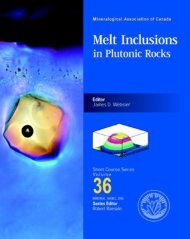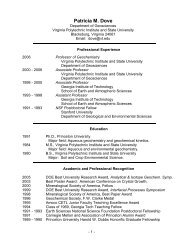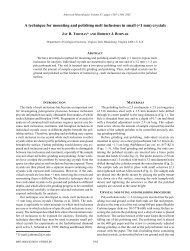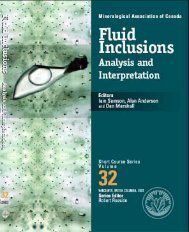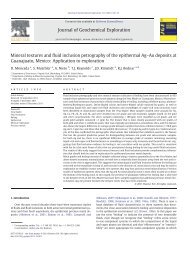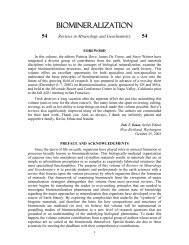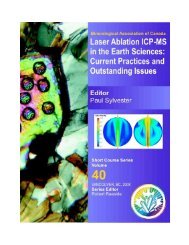Biomineralization Within Vesicles: The Calcite of Coccoliths
Biomineralization Within Vesicles: The Calcite of Coccoliths
Biomineralization Within Vesicles: The Calcite of Coccoliths
Create successful ePaper yourself
Turn your PDF publications into a flip-book with our unique Google optimized e-Paper software.
200 Young & Henriksen<strong>The</strong> Coccolithus structure is similar, but more complex—the V-unit again forms thedistal shield but also extends onto the proximal surface as a lower tube element. <strong>The</strong> R-unit forms the proximal shield, but extends on the distal surface as an upper tube element(Fig. 3A-B). As a result, the two crystal unit types are intergrown and the proto-coccolithring is embedded within the coccolith structure and only visible on broken specimens(Fig. 4D-E). Additional complexity is seen on the proximal shield with development <strong>of</strong>separate upper and lower elements growing at different angles. <strong>The</strong> upper unit isapproximately radially directed (and elongate approximately parallel to the c-axis), whilethe lower element is oblique to this (Fig. 4F). Finally on complete coccoliths, the centralarea elements on both the proximal and distal surfaces appear to be composed <strong>of</strong> a mass<strong>of</strong> minute elements, but interconnections between them are <strong>of</strong>ten visible, and atintermediate growth phases the morphology is simpler; hence these are evidently aproduct <strong>of</strong> less regular growth at a late phase.<strong>The</strong> Emiliania structure (Westbroek et al. 1989; Young 1989; Didymus et al. 1994) isunusual in being composed essentially <strong>of</strong> R-units, with the V-units confined to the protococcolithring (Fig. 6A). As a result, the individual R-units have particularly complex form,being constructed <strong>of</strong> proximal shield, distal shield, inner tube and central area elements,each <strong>of</strong> which represents a separate growth direction from the nucleation site.Ophiaster has a simple rim <strong>of</strong> alternating V- and R-units but the central area isfloored by separate elements. <strong>The</strong>se elements interdigitate with the rim units, but arecrystallographically separate and have sub-tangential c-axis orientations. This structurewith three separate crystal unit types has been described in detail for Syracosphaerapulchra (Young et al. in press).Nucleation<strong>The</strong> most remarkable common feature <strong>of</strong> the heterococcoliths is the development <strong>of</strong>the rim from a proto-coccolith ring <strong>of</strong> simple calcite crystals with alternating sub-verticaland sub-radial c-axis orientations—the V/R structure <strong>of</strong> Young et al. (1992). This isshown by each <strong>of</strong> the illustrated examples and has been demonstrated in numerous others(e.g., Young and Bown 1997; Marsh 1999; Young et al. 1999). In some cases, it has onlybeen possible to demonstrate that the rim consists <strong>of</strong> two alternating crystal unit types,not to prove that these have different c-axis orientations. For instance, in thePapposphaeraceae the rim is clearly formed from two alternating crystal unit types (e.g.,Manton and Oates 1975), but because the entire coccoliths are usually only 1-2 micronslong and specimens are rare, it has not been possible for crystallographic orientations tobe determined. However, it seems reasonable to predict that these fit the basic V/Rmodel. This means that the first stage <strong>of</strong> biomineralization is nucleation <strong>of</strong> a ring <strong>of</strong>calcite nuclei with alternating orientations. This is a distinctive feature <strong>of</strong>heterococcoliths with no obvious parallels in any other biomineralization systems and hasdemonstrably remained constant through more than 200 million years <strong>of</strong> coccolithevolution (Young et al. 1992, 1999). Moreover, nucleation controls total calciteorientation, i.e., not simply c-axis orientation, but also a-axis orientation. This isevidenced by the fact that crystal faces on adjacent elements are sub-parallel (e.g., Fig. 1,3C−G, 5A). It has also been demonstrated using SAED study <strong>of</strong> Emiliania huxleyicoccoliths (Davis et al. 1995) and AFM study <strong>of</strong> Coccolithus pelagicus and Oolithotusfragilis (Henriksen et al. in press a).A final distinctive, nucleation-related feature is that all heterococcoliths showchirality. This is seen for instance in element orientations and cross-polarized lightextinction crosses. <strong>The</strong> lower proximal shield elements <strong>of</strong> Coccolithus (Figs. 3A, 4F) area good example. <strong>The</strong>se grow at an oblique angle and always show clockwise <strong>of</strong>fset from



